Key takeaways:
- Medical decision support enhances patient care by providing evidence-based recommendations and fostering collaboration among healthcare providers.
- Integrating new research into practice is essential for maintaining current standards of care and directly impacting patient outcomes.
- A systematic assessment of new research and collaboration with interdisciplinary teams improves the application of findings in clinical settings.
- The future of decision support is likely to focus on artificial intelligence, patient-centered decision-making, and collaborative platforms for sharing best practices.
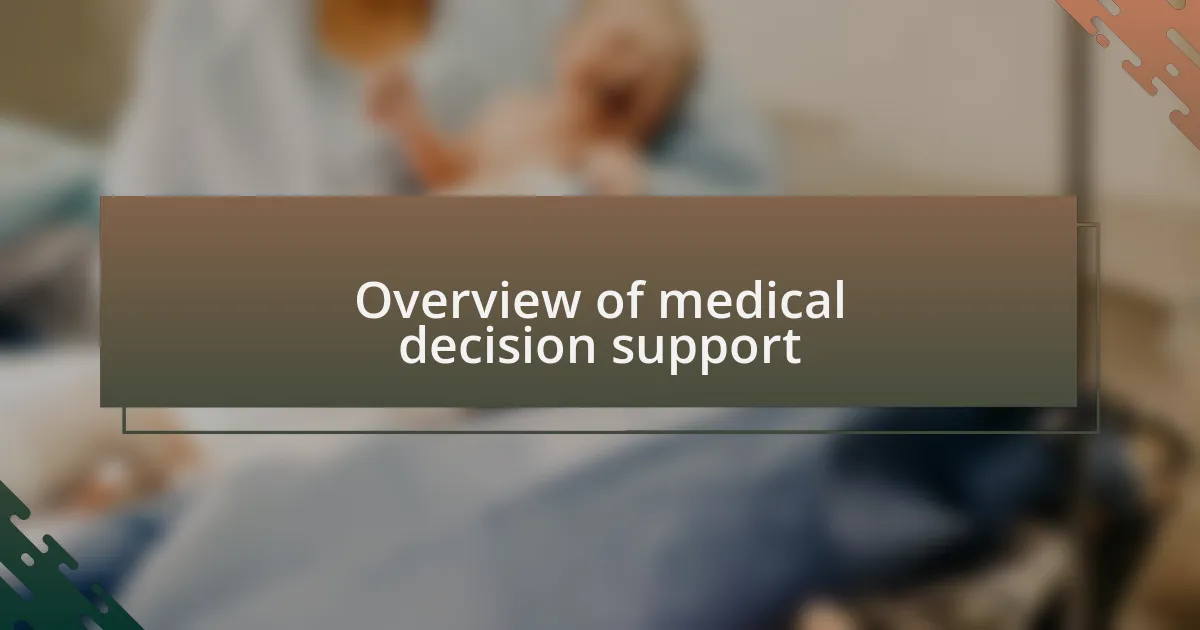
Overview of medical decision support
Medical decision support is a transformative tool in healthcare that leverages data and advanced algorithms to assist healthcare providers in making informed decisions. I’ve seen firsthand how these systems can change the dynamic in clinical settings, enhancing patient outcomes by providing evidence-based recommendations tailored to individual cases.
Imagine a physician faced with a complicated diagnosis. Wouldn’t it be comforting to have an assistant that crunches vast amounts of research, clinical guidelines, and patient history in mere seconds? It’s this blend of technology and medical expertise that creates a safety net for providers, improving accuracy while potentially reducing errors in patient care.
In my experience, the best medical decision support tools don’t just deliver information; they foster a collaborative environment where physicians can deliberate over options with confidence. They prompt critical thinking and enable discussions that genuinely consider the patient’s unique circumstances. Isn’t it remarkable how technology can enhance the human aspect of medicine?
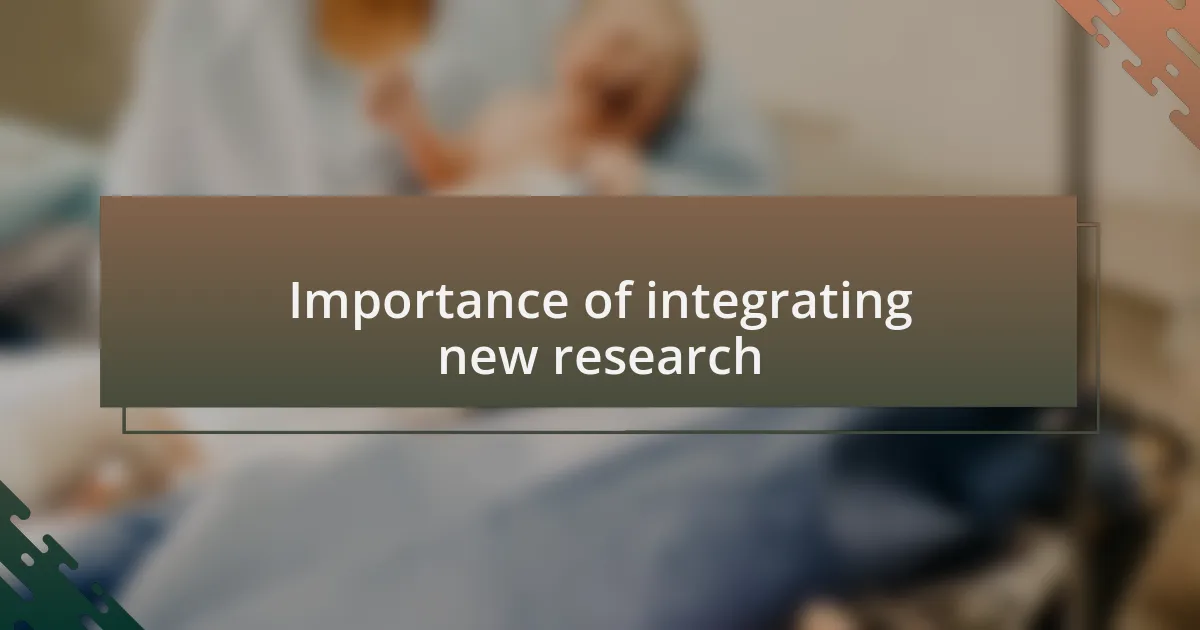
Importance of integrating new research
Integrating new research into medical decision support is crucial for keeping healthcare providers informed about the latest advancements and best practices. I remember a case where a newly published guideline on managing chronic pain changed the entire treatment plan for a patient I was involved with. It’s moments like these that highlight how essential it is for practitioners to have access to current research, ensuring that their decisions are based on the most recent evidence.
When I reflect on the evolving landscape of healthcare, it’s clear that staying updated with new research can directly impact patient outcomes. Consider a scenario where a doctor is unaware of a breakthrough in diabetes management that could drastically improve a patient’s quality of life. The integration of research isn’t just about knowledge; it’s about harnessing that knowledge effectively to create tailored, impactful care.
I also think about the risks associated with stagnation in medical practices. If healthcare providers fail to integrate new research, they might unintentionally perpetuate outdated methods that could harm patients. Isn’t it worth the effort to actively seek out and apply the latest findings in our daily practice? It’s a commitment that not only empowers the clinician but also profoundly benefits the patients they serve.
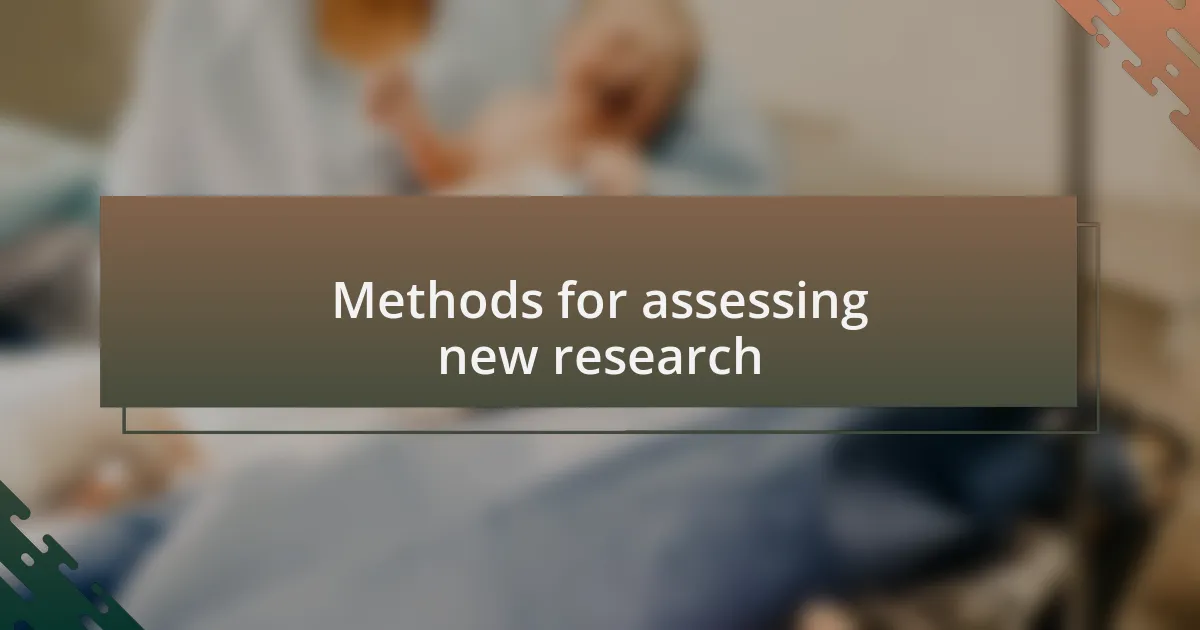
Methods for assessing new research
Assessing new research requires a systematic approach to ensure the information is not only reliable but also relevant. I often look at peer-reviewed journals first, as these articles undergo rigorous scrutiny. For example, I stumbled upon a study about the efficacy of a new anticoagulant, and it was fascinating to see robust data supporting its use that I could directly apply to my practice.
Another method I find invaluable is engaging in discussions with colleagues and attending medical conferences. Hearing different viewpoints and experiences can shine a light on new research I might have overlooked. I remember a conversation with a fellow practitioner who shared insights about a recent clinical trial, and it opened my eyes to new treatment pathways I wasn’t aware of. Have you ever had a chat that completely shifted your perspective? Those moments can inspire innovative approaches to patient care.
I also prioritize understanding the research’s context by examining the methodology and population studied. Questions like, “Does this apply to my patient demographic?” echo in my mind. This critical analysis has led me to be cautious about taking findings at face value. A research paper I evaluated about hypertension management looked promising but lacked diversity in its sample. Recognizing this gap reinforced my commitment to applying research selectively and thoughtfully, ensuring it meets the unique needs of my patients.
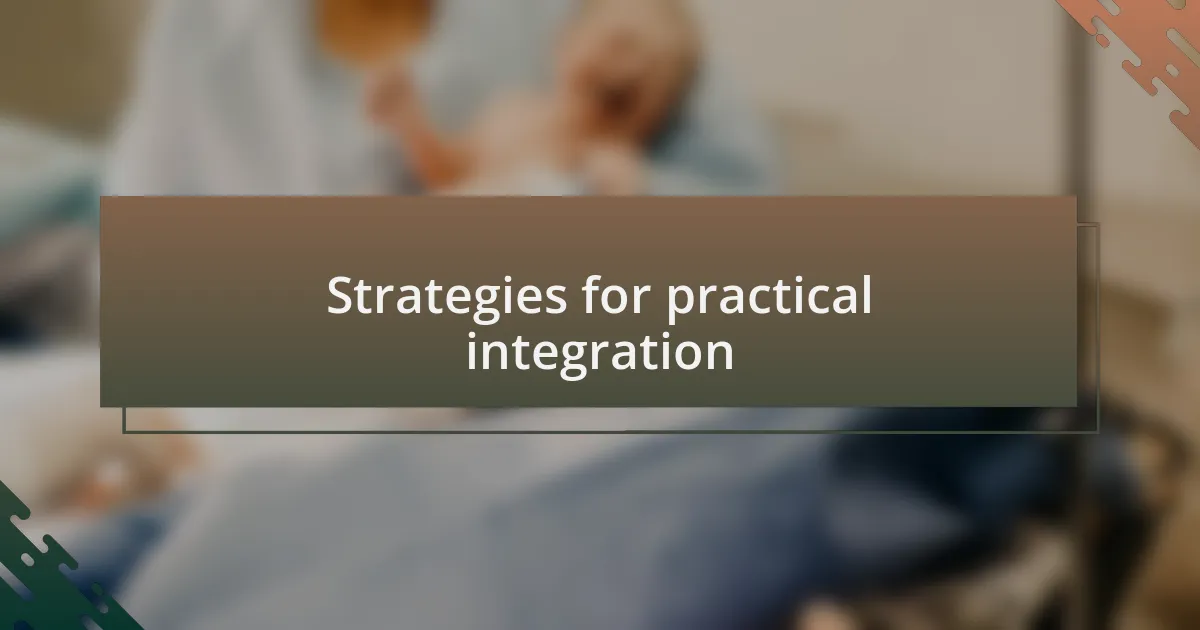
Strategies for practical integration
When it comes to integrating new research into practice, I find that developing a practical framework is essential. For instance, after identifying promising studies, I create a checklist that includes crucial factors such as relevance, applicability, and feasibility. This structured approach not only eases the integration process but also serves as a constant reminder of the research-backed practices I want to adopt.
Additionally, collaborating with interdisciplinary teams can heighten the effectiveness of research integration. I once partnered with a nutritionist when implementing new guidelines on diabetes management, and their unique perspective enriched my understanding and application of the research. Have you ever collaborated with someone whose insights made a world of difference in your approach? This teamwork fosters an environment where new findings are more easily understood and utilized.
Finally, I emphasize continuous education. Regularly revisiting and updating my knowledge about emerging studies keeps me on my toes. I often take time each week to read up on recent advancements, and I encourage my colleagues to do the same. This ongoing commitment creates a culture of curiosity and adaptation that ultimately benefits our patients. How do you keep your knowledge fresh in such a rapidly changing field? It’s essential we make space for learning in our busy schedules.
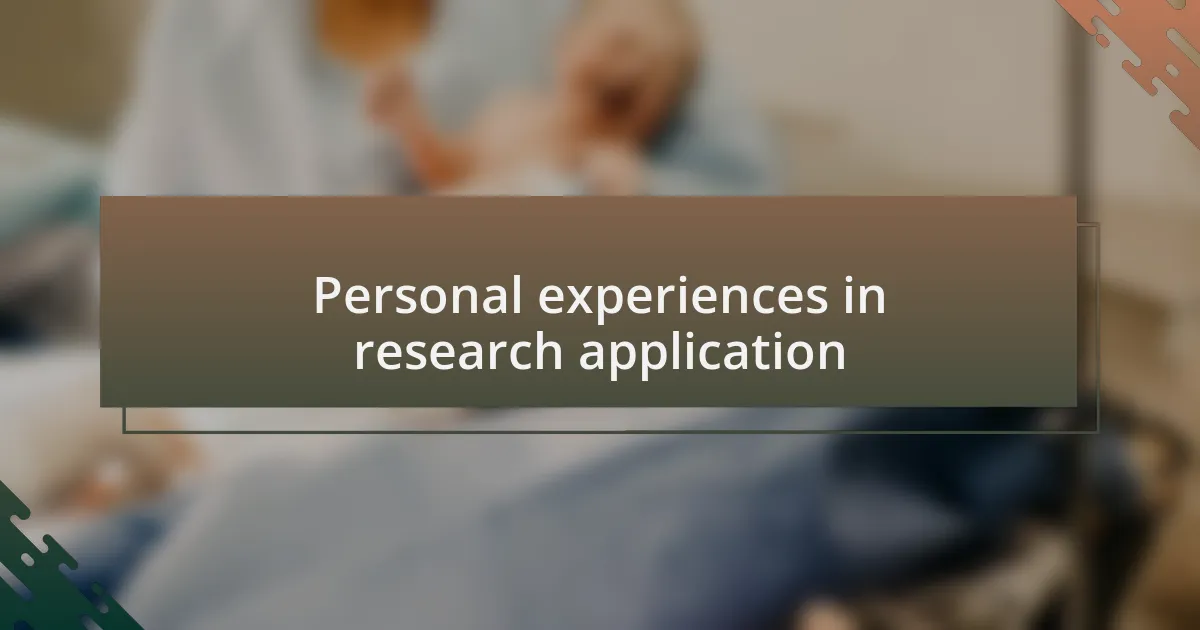
Personal experiences in research application
In my experience, applying research often feels like navigating a complex maze. I recall a time when I was tasked with implementing new evidence-based protocols on patient safety. I remember feeling overwhelmed initially, but focusing on small, actionable steps helped me gain confidence. Have you ever found a way to simplify a daunting task? It’s about breaking it down and finding your rhythm.
One instance that stands out is when I applied new studies on patient engagement. I organized a workshop that brought frontline staff together to discuss the findings. Their feedback emphasized real-world challenges that the research didn’t initially address. This collaboration not only enhanced my understanding but left me deeply appreciative of how frontline staff can bridge the gap between theory and practice. Isn’t it fascinating how diverse perspectives can illuminate aspects we might overlook?
I’ve also learned the importance of reflecting on my application processes. After integrating a new pain management protocol, I took time to evaluate its effectiveness through patient outcomes and feedback. It was enlightening to see the direct impact research could have on improving quality of care. How often do we take a step back to assess what’s really working? This reflective practice has become a cornerstone of my approach, grounding my work in data and patient experiences.
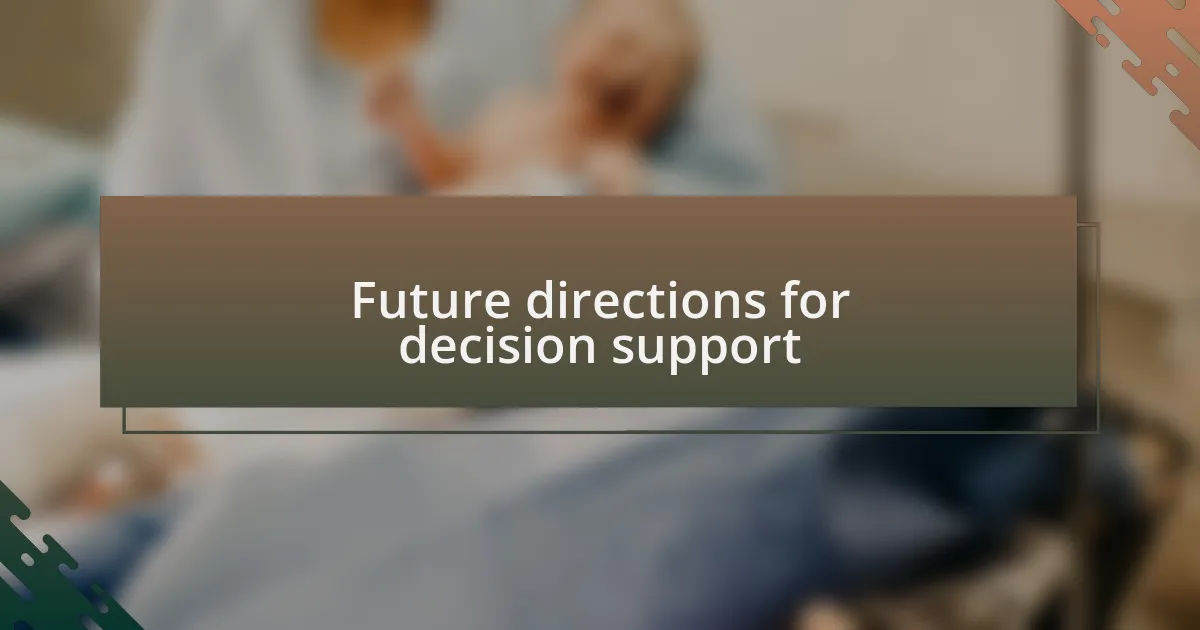
Future directions for decision support
As I look to the future of decision support, I see a significant shift towards the integration of artificial intelligence. During a recent project, I was exposed to AI tools that can analyze vast amounts of data in real time, offering practitioners insights that would take weeks to gather manually. This possibility excites me—imagine having a virtual assistant ready to help clinicians make informed decisions right at the point of care.
Moreover, I believe there will be a greater emphasis on patient-centered decision-making. I once attended a seminar where a researcher shared compelling findings about involving patients in discussions about their treatment options. Hearing patients voice their preferences completely changed my perspective. It made me realize that supporting decisions should not just be about clinical data but should also honor the individual experiences and values of patients. How do we ensure that voices are heard in this journey?
Lastly, I foresee a growing importance of collaborative platforms that connect various stakeholders in healthcare. In a recent experience, I participated in an online forum where healthcare professionals shared their experiences and strategies related to implementing new research. The diversity of thoughts and solutions provided invaluable insights that I could directly apply in my setting. Isn’t it inspiring to think how these networks can drive the evolution of decision support? The future truly looks promising as we harness collective expertise for better outcomes.